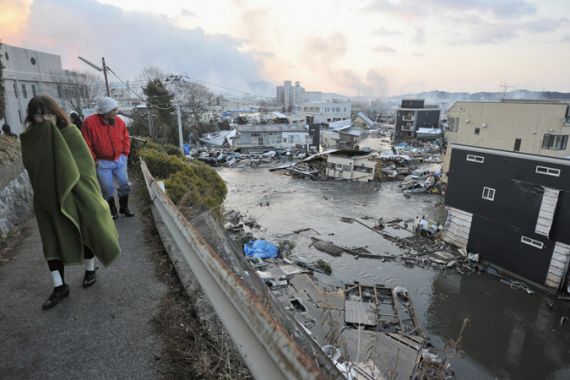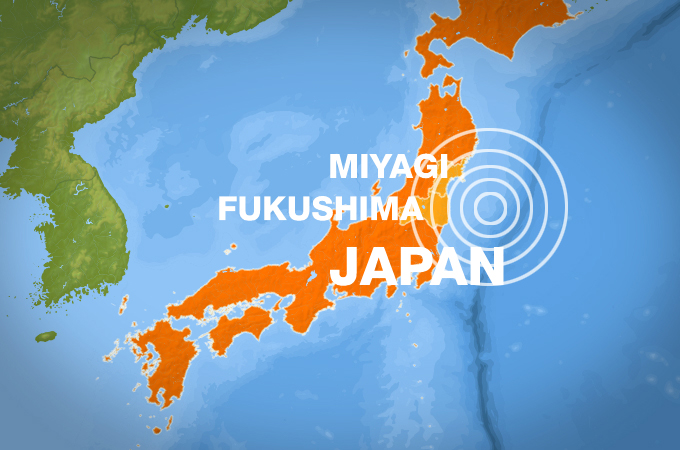Tsunami-hit Japan counts losses
Coastline swamped and hundreds dead as biggest quake in centuries sends wave crashing ashore and puts Pacific on alert.

At least 573 are confirmed killed after one of the strongest earthquakes ever recorded struck Japan, triggering a devastating 10-metre-high tsunami along parts of the country’s northeastern coastline, and triggered an emergency at two nuclear power plants.
Domestic media said on Saturday the death toll was expected to exceed 1,000, most of whom appeared to have drowned by churning waters.
Keep reading
list of 4 itemsWorld’s coral reefs face global bleaching crisis
Why is Germany maintaining economic ties with China?
Australia’s Great Barrier Reef suffers worst bleaching on record
“The damage is so enormous that it will take us much time to gather data,” an official at the national police agency said.
| LIVE BLOG |
 |
The towering wall of water, generated by the 8.9 magnitude earthquake, pulverised the northeastern city of Sendai, where police on Friday reportedly said that 200-300 bodies had been found on the coast.
The wave of black water sent shipping containers, cars and debris crashing through the streets of Sendai and across open farmland, while a tidal wave of debris-littered mud destroyed everything in its path.
The northeastern Japanese city of Kesennuma, with a population of 74,000, was hit by widespread fires and one-third of the city was under water, Jiji news agency said.
Radiation fears
|
Al Jazeera’s meteorologist explains Japan’s quake |
Japanese authorities scrambled on Saturday to prevent nuclear accidents at two atomic plants where reactor cooling systems failed, as it evacuated tens of thousands of residents.
Radiation 1,000 times above normal was detected in the control room of one plant, although authorities said levels outside the facility’s gates were only eight times above normal, spelling “no immediate health hazard”.
The two nuclear plants affected are the Fukushima No. 1 and No. 2 plants, both located about 250 kilometres northeast of greater Tokyo.
A total of 45,000 people living within a 10-kilometre radius of the No. 1 plant were told to evacuate.
Japan’s Prime Minister Naoto Kan early on Saturday morning left on a helicopter ride to Fukushima to assess the situation at the plants operated by Tokyo Electric Power, and at other areas in the disaster zone.
When Friday’s massive quake hit, the plants immediately shut down, along with others in quake-hit parts of Japan, as they are designed to do – but the No. 1 plant’s cooling system failed, the government said.
When reactors shut down, cooling systems must kick in to bring down the very high temperatures. These systems are powered by either the external electricity grid, backup generators or batteries.
This is key to prevent a “nuclear meltdown” and radioactive release. Japan’s network of advanced nuclear power plants are designed to shut down as soon as the earth shakes in one of the world’s most quake-prone countries, though a fire broke out in the turbine building of another nuclear plant in Onagawa.
International help
More than eight million homes lost power, mobile and landline phone systems broke down for many and gas was cut to more than 300,000 homes, meaning many people could not heat their dark homes during terrifying cold nights.
Japan’s military mobilised thousands of troops, 300 planes and 40 ships for the relief effort.
An armada of 20 naval destroyers and other vessels headed for the devastated Pacific coast area of Honshu island, while air force jets flew reconnaissance missions.
The unfolding natural disaster prompted offers of search and rescue help from 50 countries.
Australia pledged to throw “anything and everything” to help Japan.
China said rescuers were ready to help with quake relief, while President Barack Obama mobilised US military might to provide emergency aid after the disaster which he described as “simply heartbreaking.”
The United States, which has nearly 40,000 military personnel in Japan, has ordered a flotilla including two aircraft carriers and support ships to the region to provide aid following the tsunami.
The towering wave set off alerts across the Pacific, sparking evacuations in Hawaii and the US West Coast, and devastating at least one California port.
Chile said it was evacuating coastal areas and Ecuador’s state oil company announced it had suspended crude oil exports due to risks posed by the tsunami.
Unfolding disaster
More than 300 houses were destroyed in the remote city of Ofunato and a dam broke in the northeast prefecture of Fukushima, with homes washed away.
In Tokyo, office workers who were stranded in the city after the quake forced the subway system to close early slept alongside the homeless at one station.
Scores of men in suits lay on newspapers, using their briefcases as pillows. Kyodo said at least 116,000 people in Tokyo had been unable to return home on Friday evening due to transport disruption.
 |
There was major disruption to air travel and bullet train services. A passenger train with an unknown number of people aboard was unaccounted for on a line outside Sendai, Kyodo News reported.
The quake, which hit at 05:46 GMT and lasted about two minutes, rattled buildings in greater Tokyo, the world’s largest urban area and home to about 30 million people. It was felt in Beijing, some 2,500 km away.
The first quake struck just under 400km northeast of Tokyo, the US Geological Survey said. It was followed by more than 70 powerful aftershocks, one as strong as 7.1.
Japan sits on the “Pacific Ring of Fire” and Tokyo is in one of its most dangerous areas, where three continental plates are slowly grinding against each other, building up enormous seismic pressure.
The government has warned of a 70 per cent chance that a magnitude-eight quake will strike within the next 30 years in the Kanto plains, home to Tokyo’s vast urban sprawl.